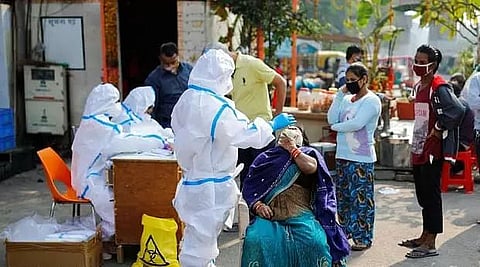
- Home
- Live Blog
- Breaking News
- Top Headlines
- Cities
- NE News
- Sentinel Media
- Sports
- Education
- Jobs

India's weekly COVID-19 positivity rate dropping to less than 5 per cent is good news but this trend might just be a lull before the storm. The COVID-19 Task Force of the Maharashtra Government has sounded a caution that the third wave of the pandemic may hit the state as early as two to four weeks. The task force has projected that the total number of cases could be double of the second wave. The state, worst hit by the second wave, apprehending a third wave within weeks of declining positivity, is an alarm bell for all states including Assam and other North-eastern states not to lower guards while unlocking. The country's active caseload declined to 8.26 lakh cases after 71 days and daily new cases dropped to 67,208 on Wednesday. For 35 consecutive days, daily recoveries outnumbered daily new cases pushing the recovery rate to 95.93 per cent. While these statistics provide a sense of relief, the hard reality is that the virus has not disappeared. On the contrary, it has mutated into a new variant of concern named by scientists as Delta plus and infections will rebound if markets get crowded and people drop their facemasks in the places that have unlocked or eased containment restrictions. The Maharashtra task force has cautioned that people who have escaped infections in the first two waves will be more vulnerable to infection in the third wave. It has apprehended that active caseload could rise to eight lakh which means saturation of hospital beds and oxygen requirement going up on a scale that may be difficult to manage if sufficient planning is not done to handle such an emergency. The Delhi government has announced its decision to train 5,000 volunteers to prepare them as Community Nursing Assistants as the country's capital also witnessed a severe shortage of medical and paramedical staff during the second wave. Besides, acute shortage in hospital beds and oxygen due to a sudden surge in infection resulted in high fatalities in Delhi, Maharashtra, and several other states. The Central government has also said that the third wave of COVID-19 pandemic in the country is inevitable. It is, however, not known about the level of preparedness in different states for the third wave for handling it effectively to reduce its ferocity and not repeat the mistakes of the second wave. The states presenting comprehensive data on the availability of beds, oxygen, medical and paramedical staff against projections of infection in the third wave will put people on high alert and remind them of the need to continue strict adherence of COVID appropriate behaviour when the state gradually unlocks. Assam cabinet's advice to cancel the Class X and Class XII final examinations of the state boards is a wise decision and an important one to prevent the examination centres from turning potential spreaders of infection and onset of a third wave while the second wave is ebbing away. It is hoped that the Education Department will be able to appreciate the apprehensions flagged by the Health Department and take a pragmatic decision fine balancing between career and health of candidates as they have not been vaccinated and more infection among children has been reported in the current wave. The state also needs to remain prepared for high flood situation and preventing vector-borne diseases during flood taking epidemic form amid the COVID-19 pandemic will be critical to effective management of double disaster. Assam State Disaster Management Authority recruiting special volunteers at the village level in high flood-prone areas and training them to render services as community health assistants on the line of Delhi will be able to ease pressure on the health department. This will also help expand the Community Surveillance Programme to all villages for early detection or COVID-19 infection or vector-borne diseases, their segregation, proper home isolation so that most hospital beds remain free for COVID-19 patients requiring oxygen or critical support. Continuing the current strategy of mapping the districts and areas based on varying degree of positivity rates and deciding the level of unlocking and restrictions accordingly will ensure keeping the circulation of the virus at the minimum. The resources of the states in the region are limited for revenue generation and complete or partial lockdowns have affected revenue collections. The Central government extending special packages for the North-eastern states to make up for the loss of revenue generation will ease the pressure of unlocking for resumption of economic activities. The region reported an increased number of cases, higher fatalities and has been witnessing pandemic disruptions for a longer duration in the second wave compared to the first wave. Guwahati being the gateway to the region will remain vulnerable to be gripped by a fresh surge in infection after the state and the region unlock fully. Public and government complacency is the biggest pandemic trap.